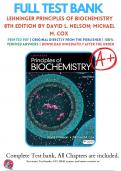PRINTED PDF | ORIGINAL DIRECTLY FROM THE PUBLISHER | 100%
VERIFIED ANSWERS | DOWNLOAD IMMEDIATELY AFTER THE ORDER
For more Test banks, ATI, HESI exams, and more contact us.
FULL TEST BANK
L e h n i n g e r P r i n c i p l e s o f B i o c h e m i s t r y
8 t h E d i t i o n B y D a v i d L . N e l s o n ; M i c h a e l
M . C o x Complete Test bank, All Chapters are included. Stuvia.com - The Marketplace to Buy and Sell your Study Material
Table of Contents
Chapter 01. The Foundations of Biochemistry 1
Chapter 02. Water, the Solvent of Life 20
Chapter 03. Amino Acids, Peptides, and Proteins 38
Chapter 04. The Three-Dimensional Structure of Proteins 65
Chapter 05. Protein Function 85
Chapter 06. Enzymes 103
Chapter 07. Carbohydrates and Glycobiology 123
Chapter 08. Nucleotides and Nucleic Acids 142
Chapter 09. DNA-Based Information Technologies 161
Chapter 10. Lipids 178
Chapter 11. Biological Membranes and Transport 195
Chapter 12. Biochemical Signaling 212
Chapter 13. Introduction to Metabolism 227
Chapter 14. Glycolysis, Gluconeogenesis, and the Pentose Phosphate Pathway 247
Chapter 15. The Metabolism of Glycogen in Animals 270
Chapter 16. The Citric Acid Cycle 281
Chapter 17. Fatty Acid Catabolism 299
Chapter 18. Amino Acid Oxidation and the Production of Urea 318
Chapter 19. Oxidative Phosphorylation 334
Chapter 20. Photosynthesis and Carbohydrate Synthesis in Plants 352
Chapter 21. Lipid Biosynthesis 368
Chapter 22. Biosynthesis of Amino Acids, Nucleotides, and Related Molecules 385
Chapter 23. Hormonal Regulation and Integration of Mammalian Metabolism 402
Chapter 24. Genes and Chromosomes 419
Chapter 25. DNA Metabolism 436
Chapter 26. RNA Metabolism 453
Chapter 27. Protein Metabolism 470
Chapter 28. Regulation of Gene Expression 490Stuvia.com - The Marketplace to Buy and Sell your Study Material
Downloaded by: Quizmatics | paulwilson55497@yahoo.com
Distribution of this document is illegalWant to earn $1.236 extra per year? Stuvia.com - The Marketplace to Buy and Sell your Study Material
https://www.stuvia.com/en-us/user/AllStudyGuidesWWW.TBSM.WSChapter 01. The Foundations of Biochemistry Multiple Choice 1. Hereditary information (with the exception of so me viruses) is preserved in: a. deoxyribonucleic acid. b. membrane structures. c. nuclei. d. polysaccharides. e. ribonucleic acid. ANSWER: a 2. Accurate folding of a protein does NOT depend on: a. proper pH. b. correct ionic strength. c. correct temperature. d. correct metal ion concentration. e. binding to DNA. ANSWER: e 3. What is the correct name for the configuration o f the molecule shown? a. orthogonal b. trans c. cis d. zis e. chiros ANSWER: c 4. Which statement is NOT true about the formation o f early organisms? a. The first organisms were anaerobic because the atmosphere was devoid of oxygen. b. The original electron donor for photosynthetic proces ses was probably H 2S. c. Oxygen, a powerful oxidant, was probably welcomed by anaerobic organisms as a preferable choice for metabolic reactions. d. The transfer of electrons to O 2 releases more energy than transferring electrons t o SO 2– e. Cyanobacteria are modern descendants of early photosynthetic oxygen -producers. ANSWER: c 5. Enzymes are biological catalysts that enhance the rate of a reaction by: a. decreasing the activation energy. b. decreasing the amount of free energy released. c. increasing the activation energy. d. increasing the amount of free energy released. ______________________________________________________________________________ ________________
_____________________________________________________________________________________________Test Bank - Lehninger Principles of Biochemistry, 8th Edition (Nelson, 2022)
1 | P a g e Stuvia.com - The Marketplace to Buy and Sell your Study Material
Downloaded by: Quizmatics | paulwilson55497@yahoo.com
Distribution of this document is illegalWant to earn $1.236 extra per year? Stuvia.com - The Marketplace to Buy and Sell your Study Material
https://www.stuvia.com/en-us/user/AllStudyGuidesWWW.TBSM.WS e. increasing the energy of the transition state. ANSWER: a 6. Which ranking correctly describes the rigidity o f the red bond (the central bond) shown in the figure ? a. 2 = most rigid, 3 = least rigid b. 1 = most rigid, 5 = least rigid c. 4 = most rigid, 3 = least rigid d. 2 = most rigid, 1 = least rigid e. 4 = most rigid, 1 = least rigid ANSWER: c 7. When Stanley Miller, in Harold Urey's laboratory , subjected a gaseous mixture mimicking the prebioti c atmosphere on Earth to electrical sparks, he found that were form ed. a. amino acids b. aldehydes c. ribonucleotides d. both amino acids and aldehydes e. amino acids, aldehydes, and ribonucleotides ANSWER: d 8. In the theory for the origin of life that was te sted by Miller and Urey, the prebiotic atmosphere was presumed to: a. already contain some primitive RNA molecules. b. basically be very similar to the atmosphere of today. c. contain many amino acids. d. have an abundance of methane, ammonia, hydrogen, and water. e. be rich in oxygen. ANSWER: d 9. An increase in the entropy of a system can be des cribed as an increase in the total amount of of a s ystem. a. kinetic energy b. potential energy c. oxidative energy ______________________________________________________________________________ ________________
_____________________________________________________________________________________________Test Bank - Lehninger Principles of Biochemistry, 8th Edition (Nelson, 2022)
2 | P a g e Stuvia.com - The Marketplace to Buy and Sell your Study Material
Downloaded by: Quizmatics | paulwilson55497@yahoo.com
Distribution of this document is illegalWant to earn $1.236 extra per year?





